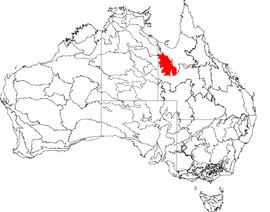Mount Isa Inlier, an interim Australian bioregion, is located in the Queensland,[1][2] and comprises 6,778,263 hectares (16,749,450 acres).[3]
| Mount Isa Inlier Queensland | |||||||||||||||
|---|---|---|---|---|---|---|---|---|---|---|---|---|---|---|---|
 The interim Australian bioregions, with Mount Isa Inlier in red | |||||||||||||||
| Area | 67,782.63 km2 (26,171.0 sq mi) | ||||||||||||||
| |||||||||||||||
The bioregion has the code MII.[3] There are three subregions.[3][4]
| IBRA regions and subregions: IBRA7 | ||||
|---|---|---|---|---|
| IBRA region / subregion | IBRA code | Area | States | Location in Australia |
| Mount Isa Inlier | MII | 6,778,263 hectares (16,749,450 acres) | Qld | 
|
| Southwestern Plateaus and Floodouts | MII01 | 1,333,519 hectares (3,295,200 acres) | ||
| Thorntonia | MII02 | 802,892 hectares (1,983,990 acres) | ||
| Mount Isa | MII03 | 4,641,851 hectares (11,470,260 acres) | ||
See also
editReferences
edit- ^ Environment Australia. "Revision of the Interim Biogeographic Regionalisation for Australia (IBRA) and Development of Version 5.1 - Summary Report". Department of the Environment and Water Resources, Australian Government. Archived from the original on 5 September 2006. Retrieved 31 January 2007.
- ^ IBRA Version 6.1 data
- ^ a b c "Interim Biogeographic Regionalisation for Australia (IBRA7) regions and codes". Department of Sustainability, Environment, Water, Population and Communities. Commonwealth of Australia. 2012. Retrieved 13 January 2013.
- ^ Stanton, J. P. (James Peter); Morgan, M. G; University of New England. School of Natural Resources (1977), The rapid selection and appraisal of key and endangered sites : the Queensland case study, the University of New England School of Natural Resources, pp. 1–10, retrieved 11 February 2022
Further reading
edit- Thackway, R and I D Cresswell (1995) An interim biogeographic regionalisation for Australia : a framework for setting priorities in the National Reserves System Cooperative Program Version 4.0 Canberra : Australian Nature Conservation Agency, Reserve Systems Unit, 1995. ISBN 0-642-21371-2